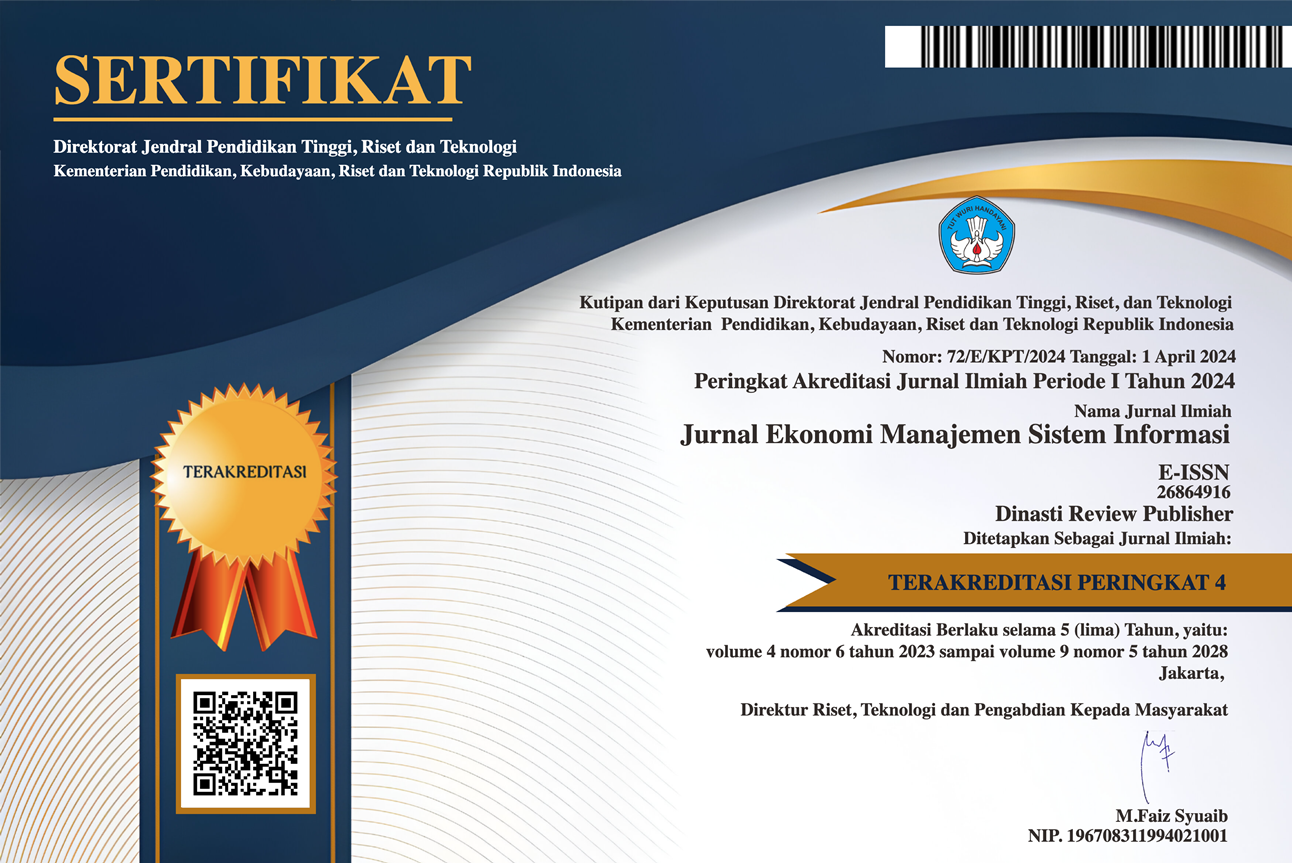Industri 4.0 dan Kinerja Perusahaan Telekomunikasi yang Terdaftar di BEI
DOI:
https://doi.org/10.38035/jemsi.v6i5.5085Keywords:
Industri 4.0, Servitisasi, Leverage, Kinerja PerusahaanAbstract
Currently, Indonesia as one of the developing countries, is gradually transitioning toward the adoption of technology in the era of Industry 4.0, as demonstrated by the government’s “Making Indonesia 4.0” program, which serves as an acceleration initiative to enter the industrial revolution era and aims to position Indonesia among the world’s top 10 economies by 2030. This highlights the importance of adapting to the industrial revolution in a dynamic business environment. This study aims to examine the influence of Industry 4.0 on firm performance with servitization and leverage as intervening variables in telecommunications companies listed on the Indonesia Stock Exchange. This is a quantitative study, and the sampling method used is non-probability sampling based on purposive sampling. The sample consists of 152 data points derived from telecommunications companies listed on the Indonesia Stock Exchange. Data analysis was conducted using path analysis with IBM SPSS Amos 21 software. The results of this study show that Industry 4.0 has a significant positive effect on firm performance and servitization, while servitization has a significant negative effect on firm performance. Industry 4.0 has a positive but not significant effect on leverage, and leverage also has no significant effect on firm performance. Servitization is able to mediate the relationship between Industry 4.0 and firm performance, whereas leverage does not.
References
Abou-foul, M., Ruiz-Alba, J. L., & Soares, A. (2021). The Impact of Digitalization and Servitization on the Financial Performance of A Firm: An Empirical Analysis. Production Planning and Control, 32(12), 975–989. https://doi.org/10.1080/09537287.2020.1780508
Ali, S., & Xie, Y. (2021). The Impact of Industry 4.0 on Organizational Performance: The Case of Pakistan’s Retail Industry. European Journal of Management Studies, 26(2/3), 63–86. https://doi.org/10.1108/ejms-01-2021-0009
Arhinful, R., & Radmehr, M. (2023). The effect of financial leverage on financial performance: evidence from non-financial institutions listed on the Tokyo stock market. Journal of Capital Markets Studies, 7(1), 53–71. https://doi.org/10.1108/JCMS-10-2022-0038
Bortoluzzi, G., Chiarvesio, M., Romanello, R., Tabacco, R., & Veglio, V. (2022). Servitisation and performance in the business-to-business context: the moderating role of Industry 4.0 technologies. Journal of Manufacturing Technology Management, 33(9), 108–128. https://doi.org/10.1108/JMTM-08-2021-0317
BPS. (2024). Indeks Pembangunan Teknologi Informasi Dan Komunikasi 2023. In BPS (Vol. 6).
Bromiley, P., & Rau, D. (2014). Towards A Practice-based View of Strategy. Business, 920(October), 1–43. https://doi.org/10.1002/smj
Denis, D. J. (2021). Applied Univariate, Bivariate, and Multivariate Statistics: Understanding Statistics for Social and Natural Scientists, With Applications in SPSS and R, Second Edition. 497–533.
Franco, A., Mitchell, M., & Skrzypacz, A. (2018). An Economic Theory of Dynamic Capabilities. The Oxford Handbook of Dynamic Capabilities, 1–24. https://doi.org/10.1093/oxfordhb/9780199678914.013.28
Ghozali, I. (2018). Aplikasi Analisis Mutivariate Dengan Program IBM SPSS 25. https://www.scribd.com/embeds/729101308/content?start_page=1&view_mode=scroll&access_key=key-fFexxf7r1bzEfWu3HKwf
Imran, M., Mustafa, G., Rehman, S. U., & Susanto, P. (2024). Effects of Industry 4.0 Technologies and Servitization on Firm Performance: Evidence from the Pakistani Manufacturing Sector. Journal of Manufacturing Technology Management. https://doi.org/10.1108/JMTM-04-2024-0206
Kemenkeu, D. (2023). Mengenal Revolusi Industri 5.0. Direktorat Jendral Kekayaan Negara Kementerian Keuangan. https://www.djkn.kemenkeu.go.id/kpknl-lahat/baca-artikel/16023/Mengenal-Revolusi-Industri-50.html
Luviani, N. H., & Pramiudi, U. (2020). Pengaruh Leverage, Profitabilitas dan Likuiditas terhadap Keputusan Hedging. Jurnal Ilmiah Akuntansi Kesatuan, 8(2), 187–196. https://doi.org/10.37641/jiakes.v8i2.377
Mao, N., & Wang, M. (2024). How does the Interaction of Digitalization and Servitization Contribute to Manufacturing Financial Performance? The Intermediary Effect of Manufacturing Innovation Performance. Heliyon, 10(19), e38312. https://doi.org/10.1016/j.heliyon.2024.e38312
Martín-Peña, M. L., Sánchez-López, J. M., & Díaz-Garrido, E. (2020). Servitization and Digitalization in Manufacturing: The Influence on Firm Performance. Journal of Business and Industrial Marketing, 35(3), 564–574. https://doi.org/10.1108/JBIM-12-2018-0400
Masdupi, E., Tasman, A., & Davista, A. (2018). The Influence of Liquidity , Leverage and Profitability on Financial Distress of Listed Manufacturing Companies in Indonesia. 57(Piceeba), 223–228.
Muhidin, S. A., & Abdurrahman, M. (2007). Analisis Korelasi, Regresi, dan Jalur. Penerbit Pustaka Setia.
Qi, Y., Mao, Z., Zhang, M., & Guo, H. (2020). Manufacturing Practices and Servitization: The Role of Mass Customization and Product Innovation Capabilities. International Journal of Production Economics, 228(January 2019), 107747. https://doi.org/10.1016/j.ijpe.2020.107747
Reski, A., & Masdupi, E. (2024). The Effect Of Capital Structure On Profitability And Stock Returns In Property And Real Estate Companies Listed On The Indonesian Stock Exchange 2015-2020. 4(2), 75–89.
Sajjad, A., Ahmad, W., Hussain, S., Chuddher, B. A., Sajid, M., & Jahanjaib, M. (2023). Assessment by Lean Modified Manufacturing Maturity Model for Industry 4.0: A Case Study of Pakistan’s Manufacturing Sector. IEEE Transactions on Engineering Management, 71, 6420–6434. https://ieeexplore.ieee.org/document/10102353
Sufianto, A., Widya, U., & Pontianak, D. (2021). Kata kunci: 6(6), 1270–1281.
Vaidya, S., Ambad, P., & Bhosle, S. (2018). Industry 4 . 0 – A Glimpse. Procedia Manufacturing, 20, 233–238. https://doi.org/10.1016/j.promfg.2018.02.034
Waluyo, D. (2024). Making Indonesia 4.0, Langkah Indonesia Menuju Era Digital dan Otomatisasi. https://indonesia.go.id/kategori/editorial/8441/making-indonesia-4-0-langkah-indonesia-menuju-era-digital-dan-otomatisasi?lang=1
Zhang, J., Sun, X., Yuan, F., & Liu, X. (2023). Which type of servitization promotes firm performance: Embedded or hybrid? Economic Modelling. https://www.sciencedirect.com/science/article/abs/pii/S0264999323002080
Zhou, K., Liu, T., & Zhou, L. (2015). Industry 4.0: Towards Future Industrial Opportunities and Challenges. 2015 12th International Conference on Fuzzy Systems and Knowledge Discovery, FSKD 2015, 2147–2152. https://doi.org/10.1109/FSKD.2015.7382284
Downloads
Published
How to Cite
Issue
Section
License
Copyright (c) 2025 Syafina Fazahra, Erni Masdupi

This work is licensed under a Creative Commons Attribution 4.0 International License.
Hak cipta :
Penulis yang mempublikasikan manuskripnya di jurnal ini menyetujui ketentuan berikut:
- Hak cipta pada setiap artikel adalah milik penulis.
- Penulis mengakui bahwa Jurnal Ekonomi Manajemen Sistem Informasi (JEMSI) berhak menjadi yang pertama menerbitkan dengan lisensi Creative Commons Attribution 4.0 International (Attribution 4.0 International CC BY 4.0) .
- Penulis dapat mengirimkan artikel secara terpisah, mengatur distribusi non-eksklusif manuskrip yang telah diterbitkan dalam jurnal ini ke versi lain (misalnya, dikirim ke repositori institusi penulis, publikasi ke dalam buku, dll.), dengan mengakui bahwa manuskrip telah diterbitkan pertama kali di Jurnal Ekonomi Manajemen Sistem Informasi (JEMSI).










































































